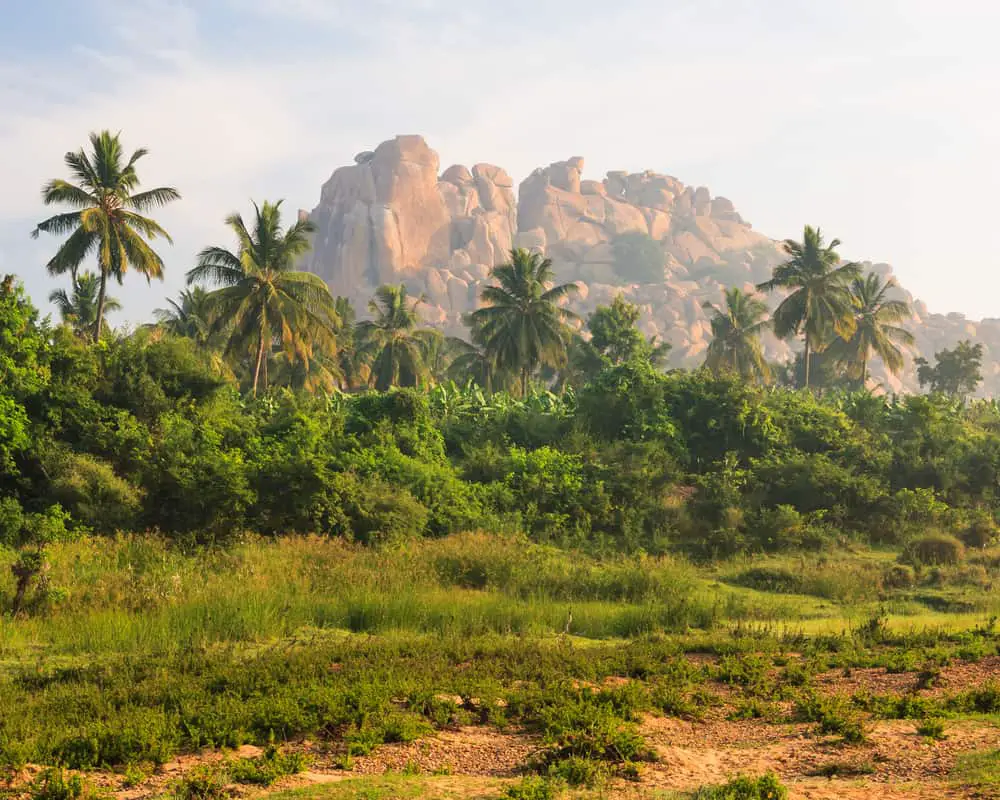
India is brimming with natural resources, so much so that the British referred to it as the “Jewel of the Empire.” With the Tropic of Cancer running through the country, India has the perfect climate for forests, but what types of forests are located in India?
India’s forests are divided into five categories according to the amount of rainfall received and species composition. These forests are Tropical, Montane subtropical, Montane temperate, Subalpine, and Alpine. These five categories are further subdivided to make 16 groups of “Forest Types.”
Over the years, India’s forests have been divided into 202 different types and subtypes within the 16 groups. But what are some examples of these, and what are the characteristic features found in each?
Table of Contents
- An Overview To The Types Of Forests Found In India
- The Five Types Of Forests Found In India, Characteristics And Examples
- Conclusion
An Overview To The Types Of Forests Found In India
India is a large country situated on the Asian continent. India lies between North 8° 4′ and 37° 6′ latitude, and East 68° 7′ and 97° 25′ longitude.
With such a vast landmass, there is a lot of diversity in climate and geology, which, in turn, gives rise to a large variety of different flora and growth forms.
Some of these forms include forests.
Around 24.6%, approximately 199,482,244 acres, of India is covered in forests; these include Tropical and Temperate Forests.
The five broad categories of forest in India are further subdivided into 16 groups, which include:
- Group 1: Tropical Wet Evergreen Forests
- Group 2: Tropical Semi-Evergreen Forests
- Group 3: Tropical Moist Deciduous Forests
- Group 4: Littoral and Swamp Forests
- Group 5: Tropical Dry Deciduous Forests
- Group 6: Tropical Thorn Forests
- Group 7: Tropical Dry evergreen
- Group 8: Subtropical Broadleaved Forests
- Group 9: Subtropical Pine Forests
- Group 10: Subtropical Dry Evergreen Forests
- Group 11: Montane Wet Temperate Forests
- Group 12: Himalayan Moist Temperate Forests
- Group 13: Himalayan Dry Temperate Forests
- Group 14: Sub Alpine Forests
- Group 15: Moist Alpine Scrub
- Group 16: Dry Alpine Scrub
The Five Types Of Forests Found In India, Characteristics And Examples
Under the five main categories of India’s Forests (Tropical, Montane subtropical, Montane temperate, Subalpine, and Alpine), there occur 16 subtypes or groups.
Each group has specific diagnostic characteristics that distinguish it from others.
These dividers are along with climate variations (rainfall and temperature), species composition, and structure.
Below each of the subgroups is broken down, and diagnostic factors are listed.
Types Of Forests Found In India: Tropical Forests
According to Champion and Seth, tropical forests are divided between “Moist” and “Dry.”
Moist Tropical Forests In India
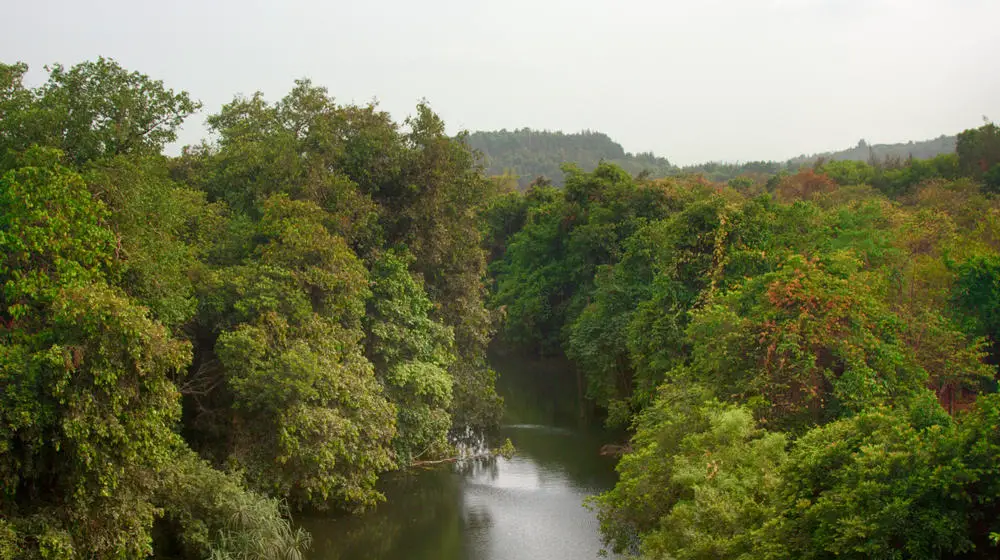
Of the sixteen forest groups, four are categorized as “Moist Tropical.” These include:
Wet Evergreen Forests In India
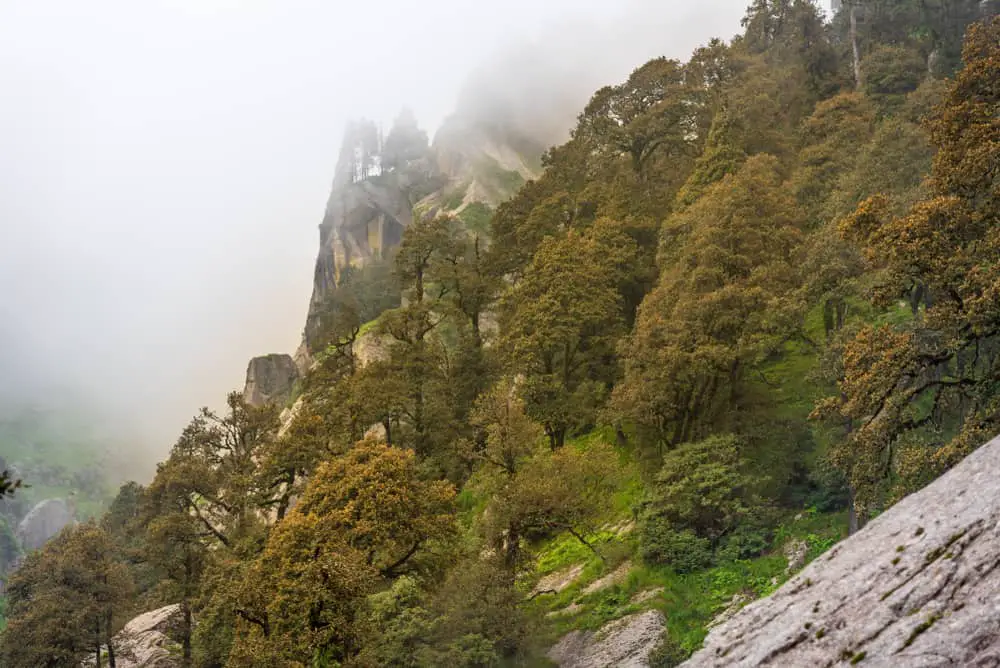
Tropical Wet Evergreen Forests (group 1) are characterized by evergreen trees that form a closed canopy.
These forests are similar to tropical rainforests. The trees can reach between 246 and 328 feet and have up to four layers or strata formed between the canopy and the ground.
These forests cover an area of 4 955 451 acres, around 2.61% of the total forested area.
Frequent monsoons help to keep these trees wet and perpetuate the evergreen status.
- Some notable species of tree include:
- Dipterocarpus grandiflorum
- Dipterocarpus costatus
- Shorea assmica (in the north)
- Hopea odorata (in the south)
- Mean annual rainfall
- Greater than 118 inches.
- Mean Annual temperatures
- Average maximum temperatures of between 80,60F and 860F.
- Average minimum temperatures of between 64.40F and 73.40F.
- Location
These forests are in Maharashtra, Karnataka, Tamil Nadu, Kerala, Andaman, West Bengal, Assam, Orissa, and the North Eastern Region.
Semi-Evergreen Forests In India
Tropical Semi-Evergreen Forests (group 2) are characterized by a mixture of deciduous and evergreen species.
The deciduous trees generally form the canopy, while the evergreen trees form the understory. This is a species diverse area that grows quite densely.
These forests cover an area of 17 586 737acres, around 9.27% of the total forested area.
- Some notable genera of tree include:
- Albizzia
- Bombax
- Cinnamomum
- Dipterocarpus
- Eugenia
- Mangifera
- Quercus
- Terminalia
- Xylia
- Mean annual rainfall
- Between 79 and 98 inches.
- Mean Annual temperatures
- Average maximum temperatures of between 82.40F and 860F,
- Average minimum temperatures of between 66.20F and 73.40F.
- Location
These forests are found in Maharashtra, Goa, Karnataka, Kerala, Andaman, Assam, West Bengal, and Orissa.
Moist Deciduous Forests In India
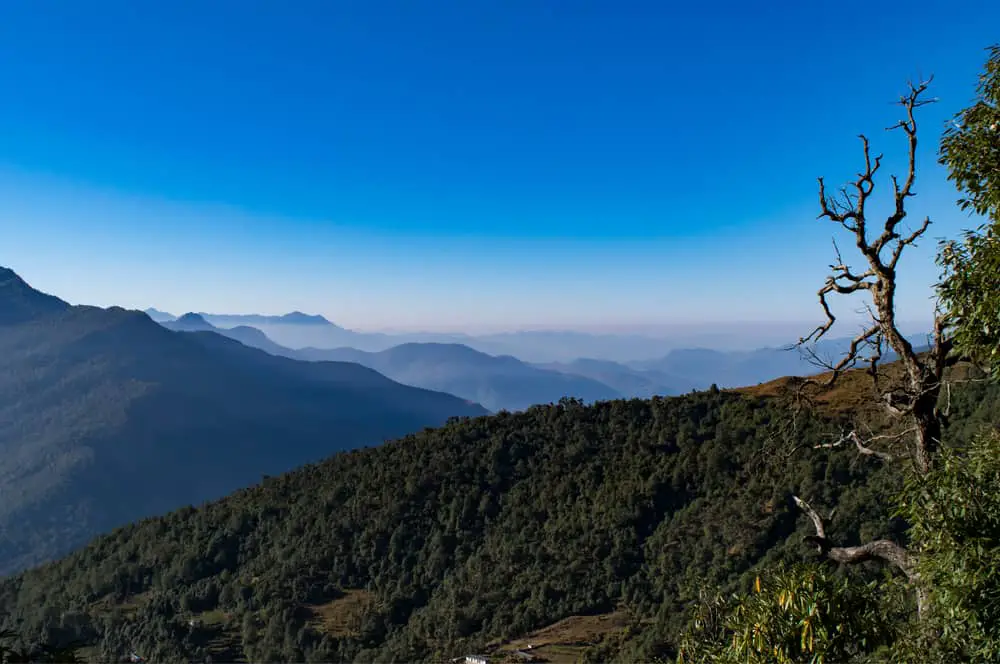
Tropical Moist Deciduous Forests (group 3) are characterized by trees that shed their leaves during the winter dry season. This area also receives less rain than in evergreen areas.
Trees found in these forests tend to have broad leaves.
These forests account for the second-highest percentage of the total forested area across India.
Canopy trees grow to heights of between 98 and 131 feet. The understory trees are also generally evergreen.
These forests cover an area of 33 465 235 acres, around 17.65% of the total forested area.
- Some notable trees include:
- Tectona grandis
- Terminalia spp
- Termilia
- Pterocarpus marsupium
- Schleichera oleosa
- Shorea robusta
- Lagerstroemia spp
- Pongamia
- Calycopteris
- Cedrela
- Adina
- Anogeissus
- Mean annual rainfall
- Between 47 and 98 inches.
- Mean Annual temperatures
- Average maximum temperatures of between 80.60F and 91.40F.
- Average minimum temperatures of between 57.20F and 680F.
- Location
These forests are found in Madhya Pradesh, Chhattisgarh, Maharashtra, Karnataka, Tamil Nadu, Kerala, Andaman and Nicobar, Uttar Pradesh, Bihar, Orissa, West Bengal, and Assam.
Littoral And Swamp Forest In India
Their location in coastal regions characterizes Tropical Littoral and Swamp Forests (group 4) in river deltas, salt marshes, tidal creeks, mudflats, and estuaries. These forests grow in both fresh and saltwater environments.
Mangroves and other freshwater swamp species are found in these forests.
They also tend to be evergreen forests.
Trees in these forests have also adapted to the tidal flooding and subsequent submerging that occurs.
The largest mangrove forest in the world is the Sundarbans, which is located in India.
India also has around 7% of the world’s total Mangrove forests.
These forests cover an area of 1 382 802 acres, around 0.73% of the total forested area.
- Some notable trees include:
- Manilkara littoralis
- Casurina equisetifolia
- Rhizophora mucronata
- Rhizophora candelaria
- Avicennia alba
- Ceriops roxburghiana
- Sonneratia
- Notable genera for Swamp Forest:
- Barringtonia
- Cephalanthus
- Glochidion
- Mean annual rainfall
- Between 19 and 122 inches.
- Mean Annual temperatures
- Average maximum temperatures of between 84.20F and 91.40F.
- Average minimum temperatures of between 64.40F and 75.20F.
- Location
These forests are found in the coastal area of West Bengal, Orissa, Andhra Pradesh, Tamil Nadu, and Gujarat. Swamp forests are generally located in the Valleys of Brahmaputra.
Dry Tropical Forests In India
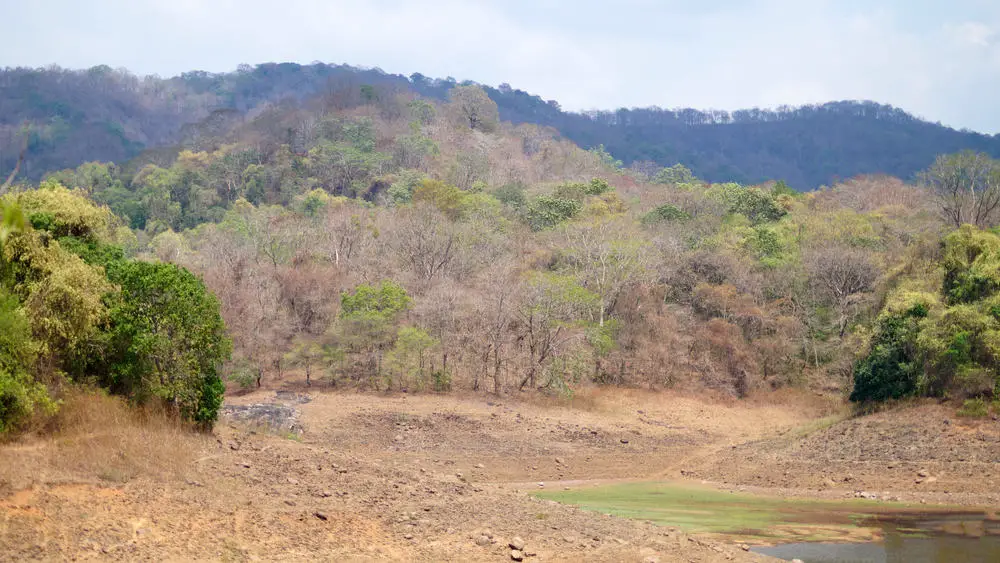
Of the sixteen forest groups, three are categorized as “Dry Tropical.” These include:
Dry Deciduous Forests In India

Tropical Dry Deciduous Forests (group 5) are characterized by their species composition. There are generally only deciduous trees that grow in these forests. The forest growth is divided into three distinct layers.
This type of forest is the most widespread across India, accounting for almost half of all forests in the country.
These forests are also referred to as the “tropical monsoon forest.”
These forests cover an area of 77 496 448 acres, around 40.86% of the total forested area.
- Some notable trees include:
- Shorea robusta
- Tectona grandis
- Anogeissus latifolia
- Terminallia tomentosa
- Buchanania lanzan
- Mean annual rainfall
- Between 31 and 47 inches.
- Mean Annual temperatures
- Average maximum temperatures of between 84.20F and 950F.
- Average minimum temperatures of between 64.40F and 770F.
- Location
These forests are found in Madhya Pradesh, Gujarat, Maharashtra, Andhra, Karnataka, Tamil Nadu, Punjab, Uttar Pradesh, Bihar, Chhattisgarh, Jharkhand, and Orissa.
Thorn Forests In India
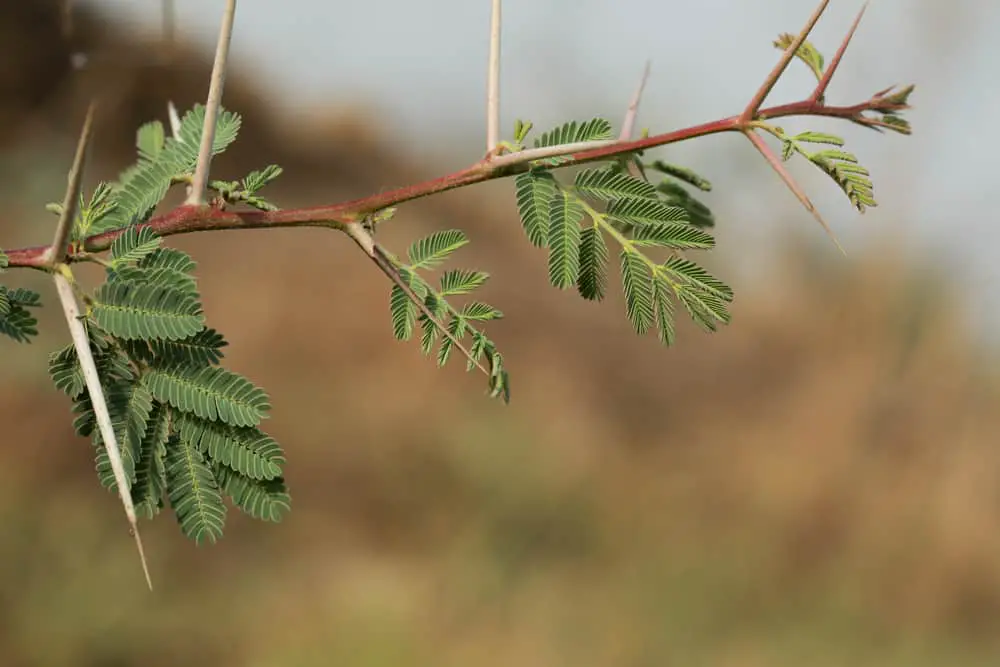
Tropical Thorn Forests (group 6) is characterized by low rainfall with a long dry season.
As a result, the tree species found in these forests have adapted to these conditions. These forests are also called “xeric forests” due to low thorny tree species, thick waxy leaves, and long, strong roots (xerophytes).
These forests are also comprised of deciduous scrub species (short trees).
Stratification is not very well defined in these forests, and surrounding Thorn Forests are generally open grasslands.
These forests cover an area of 5 158 819 acres, around 2.72% of the total forested area.
- Some notable genera include:
- Acacia
- Balanites
- Euphorbia
- Prosopis
- Salvadora
- Zizyphus
- Mean annual rainfall
- Between 8 and 31 inches.
- Mean Annual temperatures
- Average maximum temperatures of between 87.80F and 93.20F.
- Average minimum temperatures of between 64.40F and 770F.
- Location
These forests are found in Maharashtra, Andhra Pradesh, Karnataka, Tamil Nadu, Madhya Pradesh, Uttar Pradesh, Rajasthan, Gujarat, and Punjab.
Dry Evergreen Forests In India
Tropical Dry Evergreen Forests (group 7) are characterized by evergreen trees with stiff leaves.
These trees can reach heights of up to 66 feet. The trees in these forests tend to grow tightly packed together.
These forests cover an area of 231 538 acres, around 0.12% of the total forested area.
- Some notable trees include:
- Drypetes sepiaria
- Manilkara hexandra
- Memecylon edule
- Mimusops elengi
- Dispyros ebenum
- Mean annual rainfall
- Between 34 and 47 inches.
- Mean annual maximum and minimum temperatures
- Average maximum temperatures of between 89.60F and 950F
- Average minimum temperatures of between 73.40F and 75.20F.
- Location
Located on the eastern coast of Chennai, Karnataka, Andhra Pradesh, and Tamil Nadu.
Types Of Forests Found In India: Montane Subtropical Forests
Under the second “big” category of forests, Champion and Seth included three of the sixteen groups. These include:
Broadleaved Hill Forests In India
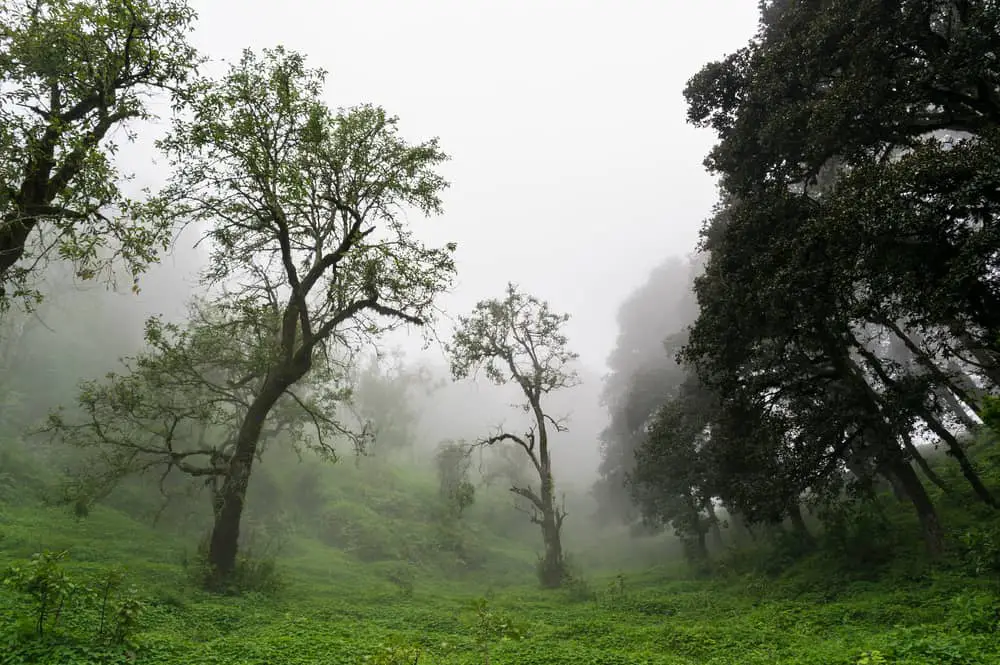
Subtropical Broadleaved Hill Forests (group 8) are characterized by high trees (up to 115 feet) in the broadleaved and evergreen categories.
These forests are usually located on hills, in particular, on the Himalayan Mountain slopes.
These forests cover an area of 8 081 829 acres, around 4.26% of the total forested area.
- Some notable trees include:
- Euginia wightiana
- Memecylon sp
- Quercus vercus
- Quercus serrata
- Castanopsis tribuloides
- Castanopsis indica
- Alnus nepalensis
- Mean annual rainfall
- Between 39 and 118 inches.
- Mean Annual temperatures
- Average maximum temperatures of between 680F and 78.80F.
- Average minimum temperatures of between 53.60F and 60.80F.
- Location
These forests are found in Maharashtra, Karnataka, Tamil Nadu, Kerala, Rajasthan, Madhya Pradesh, Orissa, West Bengal, and the North Eastern Region.
Pine Forests In India
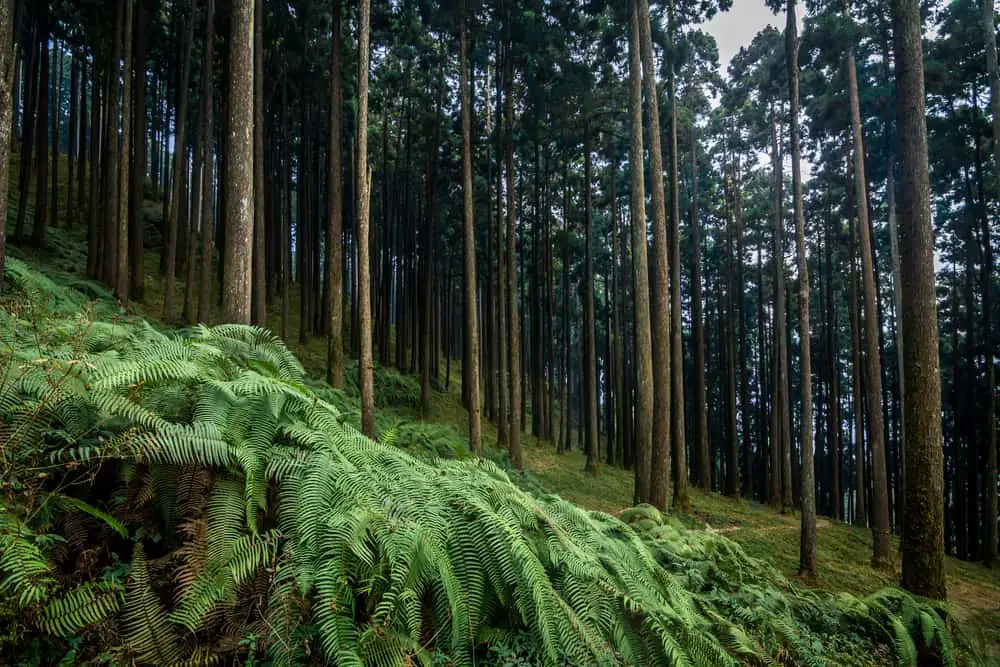
Montane Subtropical Pine Forests (group 9) are characterized by the fact that they occur on hills and slopes of the Himalayan range at altitudes of between 3281 and 6562 feet.
These forests cover an area of 4 473 102 acres, around 2.36% of the total forested area.
- Some notable trees include:
- Pinus roxburghii
- Pinus insularis
- Quercus griffithii
- Rhododendron arboretum
- Syzygium cumini.
- Mean annual rainfall
- Between 39 and 118 inches.
- Mean Annual temperatures
- Average maximum temperatures of between 680F and 770F.
- Average minimum temperatures of between 51.80F and 590F.
- Location
These forests are found in the Western and Central Himalayas, Punjab, Uttarakhand, Sikkim, Meghalaya, and Manipur.
Dry Evergreen Forests In India
Not to be confused with the “dry evergreen forests” of the tropical category.
Montane Subtropical Dry Evergreen Forests (group 10) are characterized by xerophytes tree species (waxy leaves, thorns, and long, fibrous roots), generally found on hills growing as open forests.
These forests cover an area of 44 479 acres, around 0.02% of the total forested area.
- Some notable trees include:
- Olea cuspidata
- Acacia modesta
- Punica granatum
- Dondonaea viscose
- Mean annual rainfall
- Between 20 and 39 inches.
- Mean Annual temperatures
- Average maximum temperatures of between 37.40F and 48.20F.
- Average minimum temperatures of between 75.20F and 80.60F.
- Location
Located in the Shivalik hills, Western Himalayas, Jammu, and Punjab region.
Types Of Forests Found In India: Montane Temperate Forests
According to Champion and Seth, three out of the sixteen groups of forests have been categorized under the third “main” category of the forest. These three groups are:
Wet Temperate Forests In India
Montane Wet Temperate Forests (group 11) are characterized by broadleaved species and evergreen species that grow to form closed canopies. There are, however, no conifer species present in these forests.
The roots of these trees are not buttressed, as with other forests.
There is also a strong presence of lichens and mosses in these forests, with a reduced presence of lianas and epiphytes.
These forests cover an area of 5 049 599 acres, around 2.66% of the total forested area.
- Some notable trees include:
- Ternstroemia gymnanthera
- Eugenias calophyllifolia
- Meliosma wightii
- Rhododendron nilagiricum
- Quercus lamellosa
- Machilus edulis
- Mean annual rainfall
- Between 59 and 197 inches.
- Mean Annual temperatures
- Average maximum temperatures of between 590F and 69.80F.
- Average minimum temperatures of between 48.20F and 590F.
- Location
These forests are found in Tamil Nadu, Kerala, Eastern Himalaya, West Bengal, Assam, and the North Eastern Region.
Himalayan Moist Temperate Forests In India
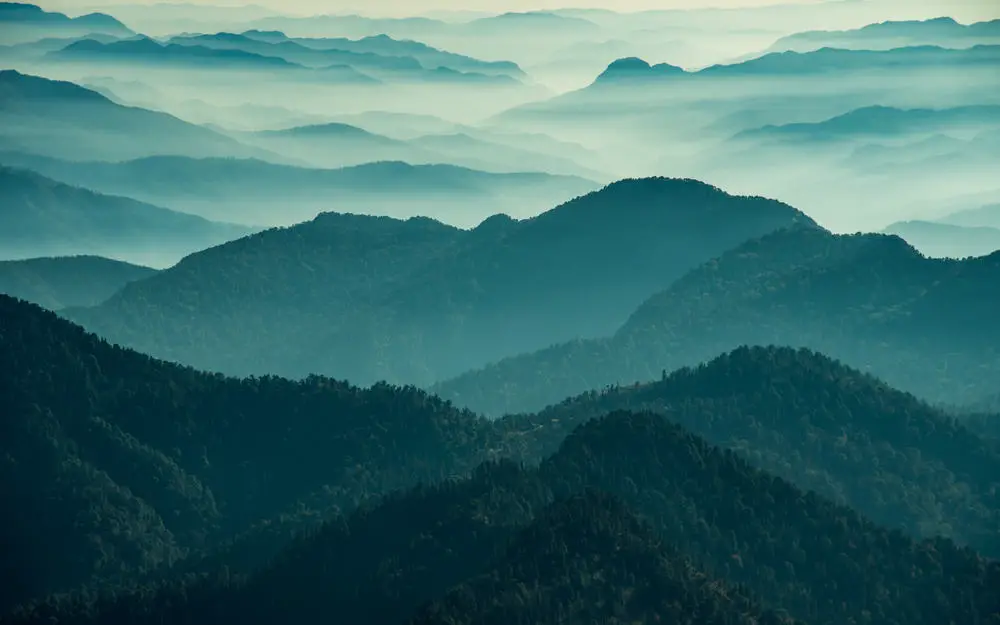
Himalayan Moist Temperate Forests (group 12) are characterized by broadleaved evergreen species, such as oak trees and conifers.
These forests are located along the Himalayas between 4921 and 10 827 feet.
Trees can reach heights of 164 feet. Different tree species are found at different forest sites due to altitude and slope direction.
These forests cover an area of 6 361 234 acres, around 3.35% of the total forested area.
- Some notable trees include:
- Abies densa
- Cedrus spp
- Picea spinulosa
- Pinus wallichiana
- Tsuga dumosa
- Quercus dilate
- Mean annual rainfall
- Between 39 and 98 inches.
- Mean Annual temperatures
- Average maximum temperatures of between 62.60F and 64.40F.
- Average minimum temperatures of between 44.60F and 51.80F.
- Location
These forests are found in Jammu, Kashmir, Punjab, Himachal Pradesh, Uttarakhand, West Bengal, Assam, and Eastern Himalaya.
Himalayan Dry Temperate Forests In India
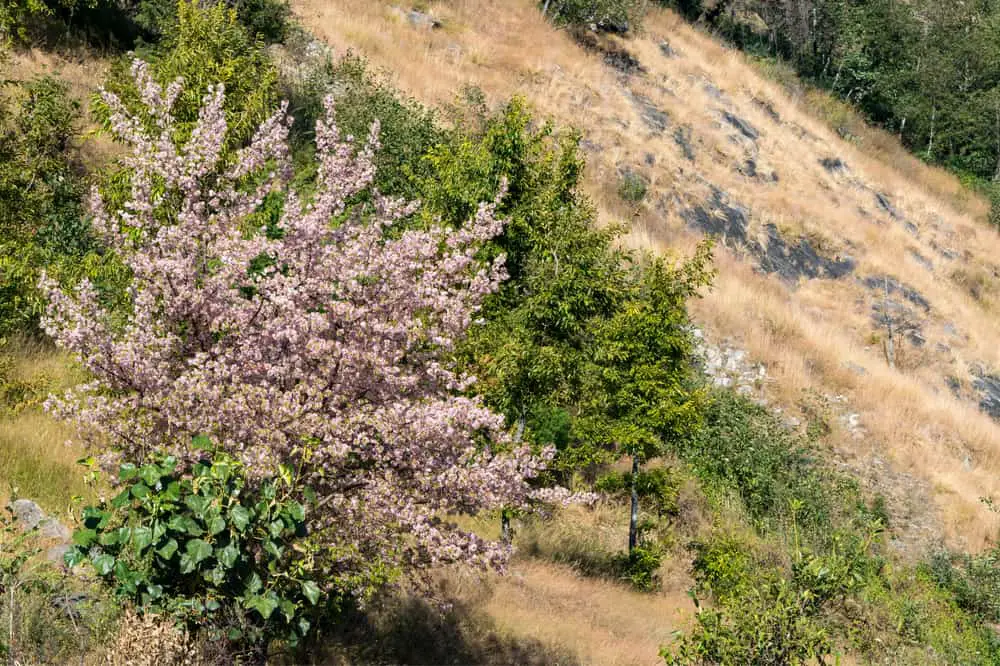
Himalayan Dry Temperate Forests (group 13) are characterized by tall trees (up to 164 feet high) growing in an open forest setting. The common species of trees found are conifers.
These forests are found along the inner valleys of the Himalayas.
These forests cover an area of 1 390 462 acres, around 0.73% of the total forested area.
- Some notable trees include:
- Cedrus deodara
- Pinus geardiana
- Juniperus wallichina
- Abies spectabilis
- Quercus ilex
- Acer pentapomicum
- Mean annual rainfall
- Less than 39 inches.
- Mean Annual temperatures
- Average maximum temperatures of between 55.40F and 71.60F.
- Average minimum temperatures of between 300F and 51.80F.
- Location
These forests are found in Jammu, Kashmir, Punjab, Himachal Pradesh, Uttarakhand, Sikkim, and the North Eastern Region.
Types Of Forests Found In India: Subalpine Forests
Subalpine forests are the only main category of forest that has one of the sixteen groups under them. This one group is of the same name.
Subalpine Forests In India
Subalpine Forests (group 14) are characterized by areas of low rainfall and low temperatures.
These forests are generally found at altitudes of between 9514 and 11 483 feet.
These forests cover an area of 3 705 345 acres, around 1.96% of the total forested area.
- Some notable trees include:
- Abies spectabilis
- Pinus wallichiana
- Betula utilis
- Rhododendron companulatum
- Quercus semecapifolia
- Mean annual rainfall
- Between 3 and 24 inches.
- Mean Annual temperatures
- Average maximum temperatures of between 48.20F and 55.40F.
- Average minimum temperatures of between 220F and 300F.
- Location
These forests are found in Jammu, Kashmir, Punjab, Himachal Pradesh, Uttarakhand, West Bengal, and the North Eastern Region.
Types Of Forests Found In India: Alpine Forests
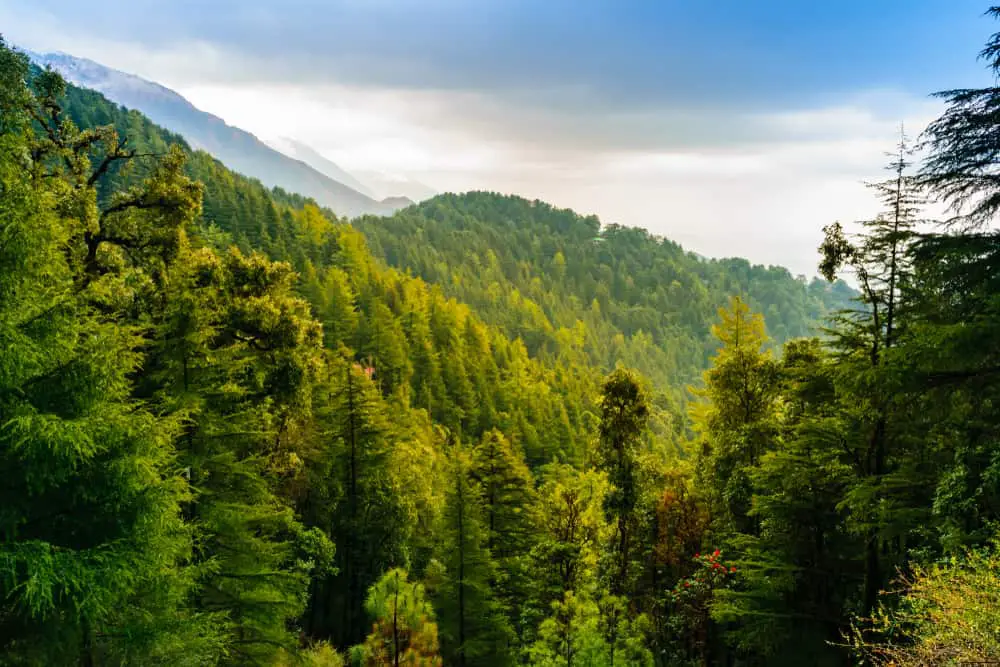
The fifth and final “main” category of forests has two of the sixteen forest groups under it. These two groups are:
Moist Alpine Scrub In India
Moist Alpine Scrub Forests (group 15) is characterized by incredibly high altitudes of up to 18045 feet. These “forests” are located above the timberline.
These forests cover an area of 236 974 acres, around 0.13% of the total forested area.
- Some notable trees include:
- Rhododendron companulatum
- Rhododendron wightii
- Rhododendron molle, thomsoni.
- Betula utilis
- Sorbus foliolosa.
- Mean annual rainfall
- Around 15 inches.
- Mean Annual temperatures
- Average maximum temperatures of around 370F.
- Average minimum temperatures of between -80F and 170F.
- Location
These forests are found in Kashmir, Uttrakhand, Sikkim, Manipur, Western and Eastern Himalayas.
Dry Alpine Scrub In India
Dry Alpine Scrub Forests (group 16) are characterized by deficient rainfall, low temperatures, high altitudes (18 044 feet), and xerophytes.
Plants in these forests need to be adapted to survive the harsh mountaintop conditions.
These forests cover an area of 722 042 acres, around 0.38% of the total forested area.
- Some notable trees include:
- Eurotia ceratoides
- Juniperus wallichiana
- Juniperus communis
- Artimisa maritima
- Artimisa Sacrorum
- Lonicera spp.
- Potentilla spp.
- Mean annual rainfall
- Less than 15 inches.
- Mean Annual temperatures
- Average maximum temperatures of around 370F.
- Average minimum temperatures of around -80F and 170F.
- Location
These forests are found in Himachal Pradesh, Kashmir, and Uttrakhand.
Conclusion
With India’s diverse range of habitats, it is understandable that there are 16 different subtypes of forests. Each of these forests plays a vital role in its communities of animals and people, and all of them should be protected.
Sources:
Vedantu: What are the Different Types of Forests in India?
Tutorials Point: What are the different types of forests found in India?
Tutorials Point: Geography India – Natural Vegetation
Drishti: Types of Forests in India
Forest Survey of India: State of Forest Report 2019
Reaserch Gate: Few examples of Indian ecosystems : forest, grassland, freshwater, marine and estuarine.
